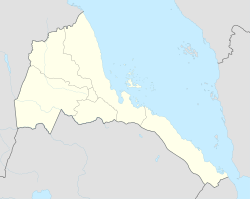Hirgigo
| Hirgigo | ||
|---|---|---|
|
|
||
| Coordinates | 15 ° 32 ' N , 39 ° 27' E | |
| Basic data | ||
| Country | Eritrea | |
| Semienawi Kayih Bahri | ||
| ISO 3166-2 | ER-SK | |
|
The Hirgigo Power Plant
|
||
Hirgigo ( Arabic حرقيقوEven Arkiko, Archigo, Arqiqo, Ercoco, Hargigo or Harkiko) is a village in the region Northern Red Sea in Eritrea . The settlement is on the mainland a few kilometers south of the port city of Massaua .
overview
Hirgigo is also known by the name Dahano, either from the Saho or Afar word for "elephant". Richard Pankhurst explains this etymology with the importance of the ivory trade for Arkiko.
In the years 1826-48 (during the Ottoman period, but not the phase under de facto Egyptian rule) parts of Eritrea were ruled by the Naib (or deputies) of Hirgigo. According to some sources, he temporarily held the post of Wali (regular military governor) of Massaua , today's capital of the area.
The city was the site of a massacre by the Derg - military dictatorship in Ethiopia in 1975, during the Eritrean War of Independence .
Eritrea's largest power plant is located in the city. This facility was partially destroyed during the Eritrean War of Independence, but was later completely repaired.
Climate and fauna
The region is believed to be one of the hottest inhabited places on earth, with temperatures rising well above 40 ° C for most of the year. This is exacerbated by an extremely low average rainfall of less than two centimeters.
In the past, large parts of the Eritrean coast were covered by mangrove forests, but today these have been destroyed by overgrazing and the felling of firewood and construction wood for houses and ships.
Today in Hirgigo mangrove trees are artificially planted with the help of inexpensive, slow fertilizer packs made from nitrogen , phosphorus and iron . This enables plant growth in areas that were previously unpopulated by trees. The project is supported by the Eritrean Ministry of Fisheries in the hope of restoring the mangrove coastline. This is intended to increase the number of livestock, fish and seafood.
Individual evidence
- ^ Richard Pankhurst: The Ethiopian Borderlands. Red Sea Press, Asmara 1997, p. 104.
- ↑ ( page no longer available , search in web archives: news.yahoo.com )


